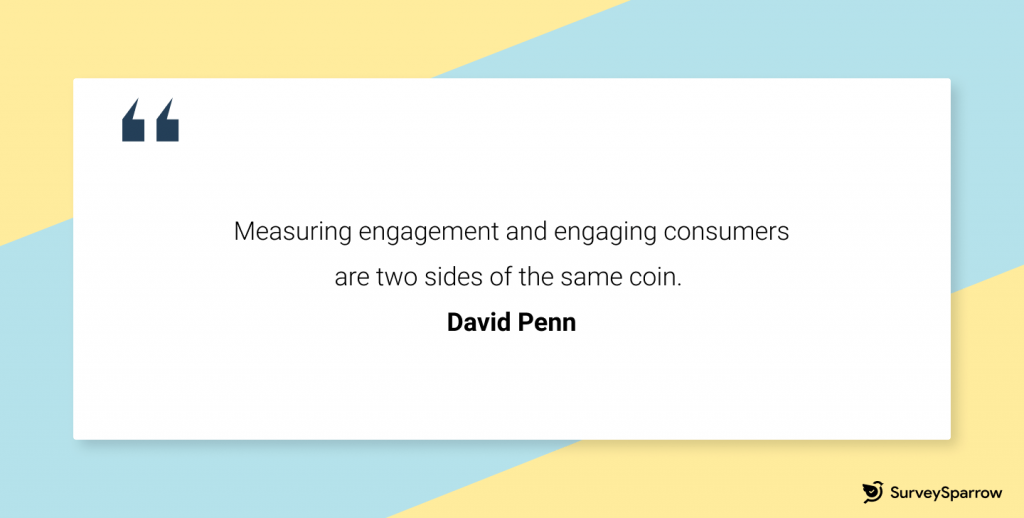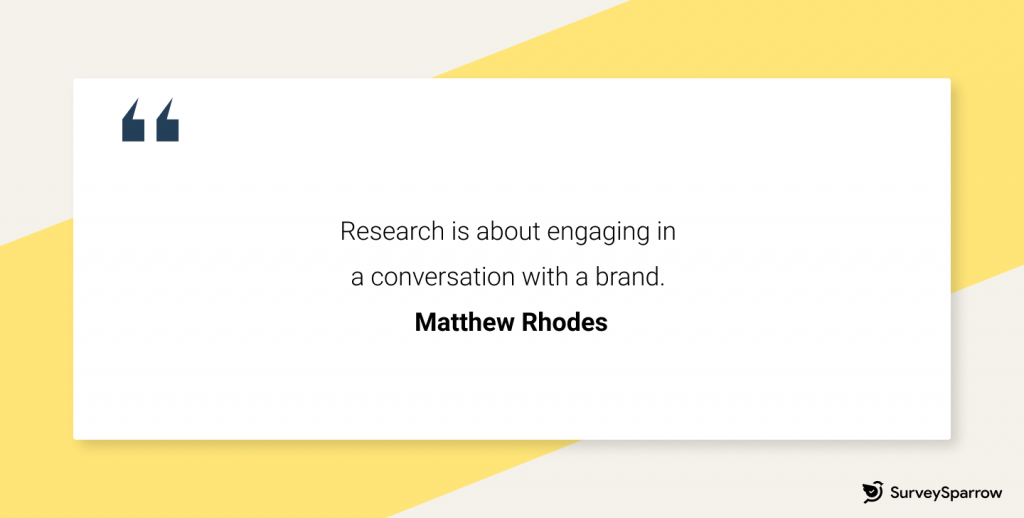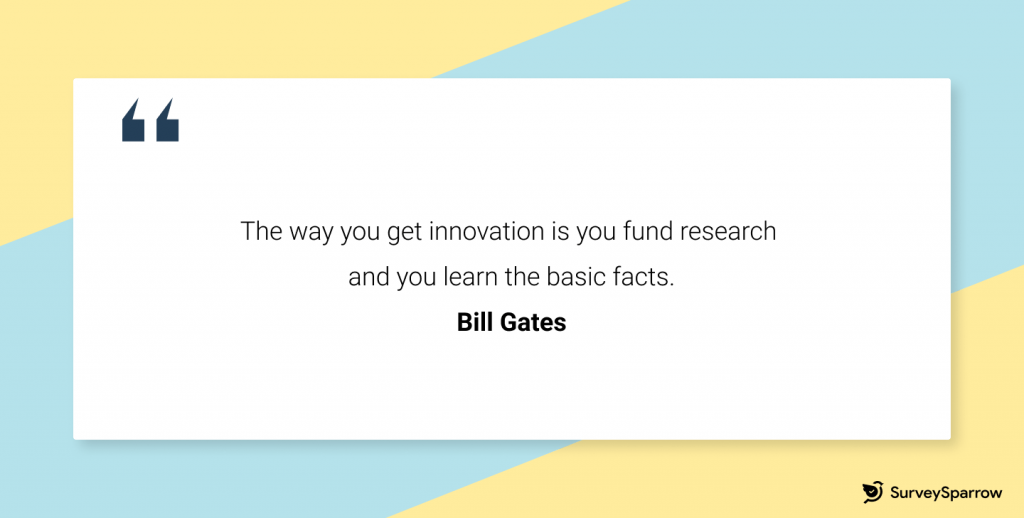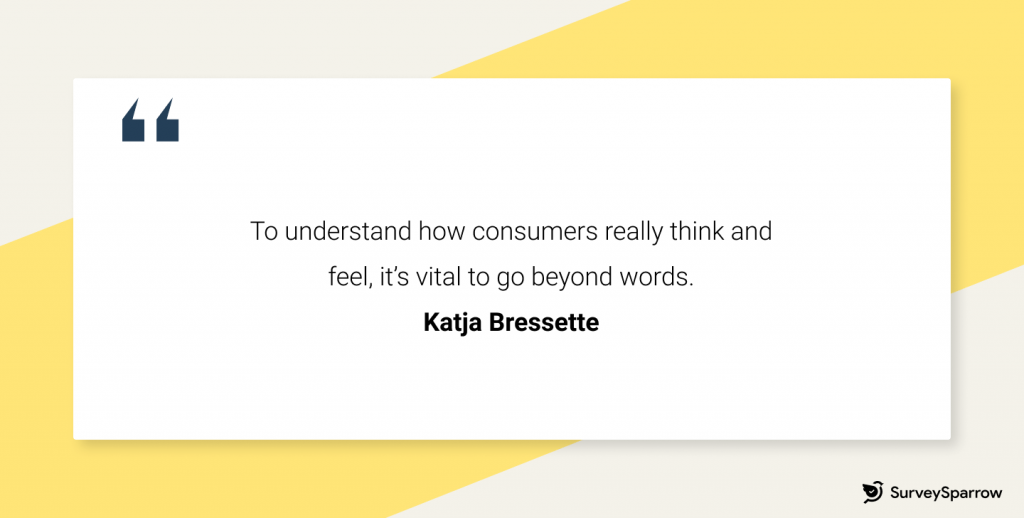Companies around the world spend billions of dollars to find out the behavior of their customers, both potential and present. They do consumer research because they want to find out the motivation of a customer, their likes and dislikes, the reason behind their affinity towards a brand and apathy towards another. Using the results from the consumer research survey, companies create behavior profiles which unearth their purchasing behavior.
This information is powerful because it can change the business to make it more in tune with what customers want. In other words:
Consumer research leads to action. Action leads to change. Change leads to better products, a better experience and better sales. Therefore, consumer research increases the bottom-line.

Objectives Of Conducting Consumer Research
Consumer research is made to answer the following questions:
- How customers behave
- Why they behave that way
- How packaging affects their buying patterns
- Why a certain set of customers buy a particular brand
- What turns off a potential customer, and more.
This data can be put many different uses. These are some of the areas where consumer research comes in very handy.
- Existing businesses can find new customer segments and markets with consumer research surveys.
- By conducting consumer research, brands can identify the target market based on various demographic factors.
- Consumer research can help customize the marketing and branding approach for various customer segments.
- When a business prepares to launch a new product, consumer research is an excellent tool to reduce business risk. It can assess demand for the product, attributes and features, study the competition and understand the most optimal methods to market. With this data, a business can reduce risk and craft a solution based on current expectations and needs.
- Businesses also want to know how to optimize existing products or services and make them better. Through research, they can get valuable feedback on existing products and services. What’s more, it makes customers feel valued.
- A good market research software helps companies find out what customers think about them. Not only does that data help you keep grounded, but it also acts as a compass to guide your strategy. Through customer research, you can measure customer sentiment and check if your product is the best fit for the market.
- Use consumer research feedback to include the latest learnings in your marketing campaigns, SEO, annual or quarterly plans, and more.
Top 10 Consumer Research Tips
That said, here are some tips will help you get the best results from your research.
1. Understand Your Potential Customer
There could be nothing more basic than this. If you don’t understand the requirements of a customer, you can’t serve them properly. Use different types of research and the existing data to find out why they behave the way they do. Make it a point to understand what motivates them to operate in a particular way.
2. Decide The Sources For Your Research
To get both qualitative and quantitative insights, it’s essential to choose the right tools and resources. You can gain valuable information by asking questions to SME (Subject Matter Experts), consultants, industry specialists, directors, managers, and other C-suite executives. As a part of the research, you can browse online portals, official government websites, free and paid sources from research companies and others.
3. Create A Buyer Persona
A buyer persona is your ideal customer with a certain set of characteristics, habits, demographics and so on. This will also include what they expect from you, what problems they want you to solve and how they plan to use your product. Buyer personas exist because it’s impossible to target everyone in your market – the idea is to choose the buyer with the most potential. It’s ideal to find at least 3-4 buyer personas and use their characteristics to target them appropriately.
4. Ask The Right Questions To Your Sources
You need to ask the right questions so that you can get information that makes business sense. Remember that the way in which C-suite executives consume information, and other people consume it, is completely different. This is why it is important to have a varied set of data. They not only give different perspectives, they provide a more detailed picture. An online survey tool like SurveySparrow provides a mix of of qualitative and quantifiable information through multiple question types, and is easy to design and deploy.
14-day free trial • Cancel Anytime • No Credit Card Required • No Strings Attached
5. Use Your Competitor’s Data Wisely
Knowing who your competitors are helps you identify what they do wrong, and as importantly, the things they do right (which you can replicate). Use the right keywords by researching the search terms used by your target customers.. Observe the first 3 pages on Google search, choose a few companies, and see the entire paradigm of activities that they do to reach out to their customers. You will also be able to find a lot of content that they have created which you can use to build your own set of content like blogs, videos, interviews, white papers, reports and so on.

6. Build A Community For Your Products
Building a community revolving around your products and services is probably the best thing that you can do. But it is immensely time-consuming to develop and build a community. Creating a community means you have to serve the customers in the community in such a way that their queries will be solved immediately. Having such a community makes it immensely easy to conduct consumer research. In fact, the best results for a consumer research survey will come from this particular group as people from a community are much more engaged than normal. It reduces the time taken to find the right set of people because they are already there as a part of the community.
Contact people in your email list and request them to be a part of the community. You can either host it on a Facebook or Slack group or on your website itself. Use existing groups to create awareness about your business and leverage it to create a community for you.
7. Offer Incentives To Be A Part Of The Survey
While it is important to offer some sort of incentive for people who are willing to be a part of your consumer research, money is not always the best incentive. There are a lot of clever incentives that you can use as a giveaway which will be a win-win for both the parties. Try offering discounts, free consultation, free usage of the product for a few days, and more. The little extra that you offer will be the impetus behind people completing the surveys. Offer complementary products and services as well, which you can offer as an extra compensation for their time.
8. Use A Conversational Tone
Remember just one thing, people are extremely happy to talk to another human being over a machine. This is why even if they are using a machine to respond to your survey, the questions should be phrased in a way that it feels like a conversation. If the survey is in the form of everyday conversation, people respond better to it. Communicate with them in a language and context that they will find it easy to respond to. Using such a format will also help you to form a ‘connection’ with them.
9. Ensure That The Survey Is Engaging
Concentrating on something as simple as making the survey attractive will increase the response to the survey. The survey design is more than just colors and using fancy buttons. There are so many factors to make surveys work, including survey time, making it work on all devices, using different types of visual aids on the survey, and more.
10. Don’t Call It A ‘Consumer Research Survey’
Of course, you are sending a survey, but it is best advised not to message that way. Call your survey something else other than a survey or a market research or a consumer survey. Tell the customer that you are looking for advice. Here are some of the alternatives you could use:
“We would like to pick your brain”
“Here is what we would like to ask you”
“We are looking for advice from you”
The above three are just examples that you can expand on. Do your own thing and make it right!

Step-by-Step Guide To Carry Out A Consumer Research Survey
Step #1: Define The Outcome Of The Research
Find out a highly measurable outcome that you would like to achieve as a part of the consumer research. For example, you might want to know if your target audience is open a specific set of features, and for each extra tier of features, there is a separate payment required. After the research, you might come to know that your potential customers would rather have just three plans to choose from and not a plethora of options that would confuse them. Having a clearly defined goal helps you to select the correct sample for the survey.
Step #2: Identify Target Audience
The kind of relationship that you share with your target audience for the consumer research is also important. Are these your existing paying customers? Are these customers who use the free version of your product? Have they shown interest in your product earlier? Is this going to be a cold email sprint? Is this from an email list that you randomly purchased from a third-party or you have nurtured them over the years by providing free information? Are these your subscribers? You might want to segment these customers of yours on a different basis as your messaging needs to change accordingly.
Step #3: Draft The Survey
The next step after deciding on who to target is drafting the right questions for the consumer research. This includes choosing the right question types, phrasing the questions, choosing the order in which the questions are going to be presented and so on. Getting this right makes a lot of difference in the outcome of this exercise. A logical flow of questions to your customers can bring out the best results. Do not ask complex questions that the average customer might not be able to understand. Run the survey questions and the flow to a few of the stakeholders who would be able to better qualify its effectiveness.
Step #4: Have A Survey Distribution Plan
Gone are the days when distributing the survey means giving out paper questionnaires, sitting with the respondent and waiting until they complete the survey. Today, the easiest method to do a survey that offers the highest and most relevant responses are online surveys. Online surveys are not only scalable, but they are easy to distribute and comes with zero costs unless you are using a tool. However, this will only make the process smoother.
Step #5: Collate The Data
After designing the survey and using an online survey tool like SurveySparrow, the next step is to collect the data (which happens automatically on the app). You can even sign up with the free version of SurveySparrow to check out how it works and see if it assists with your requirements.
Step #6: Analyzing The Data
After collecting data using the online survey tool, the next step is to analyze the data and see what the customers have actually tried to tell you. The online survey software for consumer research usually comes with a dashboard that has different capabilities to analyze and view the data. It can show the significance of the responses, and a simple glance can help collect a lot of information that can be used to make changes in the business.
Step #7: Take Action On The Feedback Received
The most important step is to take action based on the feedback that you have received from your customers. If there are areas that need to be evaluated and worked on immediately, then do not hesitate. Make plans to work on the most pressing issues at hand. If you are averse to making small changes, fret not, there is the option to take incremental steps so that it doesn’t affect the overall working of your business/product/service. Once you make changes, go back to your customers and tell them. This will increase the trust your customers have in you and your business.
Conclusion
Consumer research is one of the most effective elements in your marketing strategy and when rightly used, the kind of effect it can have is multifold. Now that we have established how important consumer research is and how you can do one as well along with tips on optimizing it, you should help your business by doing the same. Since you will be looking for a good online survey tool using which you can distribute the survey, check out SurveySparrow and use it to get highly insightful ideas to improve your business problem.







